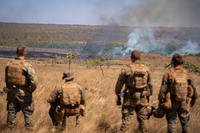CLEVELAND — The 9th Coast Guard District and Canadian Coast Guard concluded Operation Taconite and Operation Coal Shovel, its ice-breaking operations in the Great Lakes Saturday, officially bringing the 2012-13 icebreaking season to a close.
Under control of Coast Guard Sector Sault Ste. Marie, Mich., Operation Taconite is carried out in Lake Superior, the St. Mary’s River, the Straits of Mackinac, and northern Lake Huron. Operation Coal Shovel is controlled by Coast Guard Sector Detroit and is carried out in southern Lake Huron, the Detroit/St. Clair River systems, Lakes Erie and Ontario, and the St. Lawrence Seaway.
Operation Taconite began Dec. 17, 2012. Working together during this year's ice-breaking season were crews aboard: U.S. Coast Guard Cutters Mackinaw; Alder; Hollyhock; Mobile Bay; Neah Bay; Katmai Bay; Biscayne Bay; Thunder Bay, which was temporarily assigned to the Great Lakes from its homeport of Rockland, Maine; the Canadian Coast Guard Ships Samuel Risley and Griffon,.
Operation Coal Shovel began Jan. 3, 2013.
Together these 10 cutters spent more than 3,000 hours breaking ice, assisting hundreds of vessel transits.
"The Coast Guard works closely with the Canadian Coast Guard and industry to ensure critical shipping paths are open for transit," said Lt. Cmdr. Matt ten Berge, head of domestic ice breaking at the 9th Coast Guard District.
"Our ice-breaking services enable commercial shippers on both sides of our shared border to transport an average of two billion dollars worth of cargo each winter, including critical heating fuel and food supplies."
Although ice has melted from the waterways and air temperatures may be mild, water temperatures are still extremely cold and can cause hypothermia and death within a matter of minutes. Recreational water users are advised to dress for the water temperature and not the air, and to consider these factors before venturing out onto the water.

























